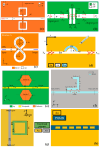Plasmonic Sensors Based on a Metal-Insulator-Metal Waveguide-What Do We Know So Far?
- PMID: 39598935
- PMCID: PMC11598660
- DOI: 10.3390/s24227158
Plasmonic Sensors Based on a Metal-Insulator-Metal Waveguide-What Do We Know So Far?
Abstract
Metal-insulator-metal (MIM) waveguide-based plasmonic sensors are significantly important in the domain of advanced sensing technologies due to their exceptional ability to guide and confine light at subwavelength scales. These sensors exploit the unique properties of surface plasmon polaritons (SPPs) that propagate along the metal-insulator interface, facilitating strong field confinement and enhanced light-matter interactions. In this review, several critical aspects of MIM waveguide-based plasmonic sensors are thoroughly examined, including sensor designs, material choices, fabrication methods, and diverse applications. Notably, there exists a substantial gap between the numerical data and the experimental verification of these devices, largely due to the insufficient attention given to the hybrid integration of plasmonic components. This disconnect underscores the need for more focused research on seamless integration techniques. Additionally, innovative light-coupling mechanisms are suggested that could pave the way for the practical realization of these highly promising plasmonic sensors.
Keywords: metal–insulator–metal waveguide; plasmonics; surface plasmon polariton.
Conflict of interest statement
The author declares no conflicts of interest.
Figures







Similar articles
-
Orthogonal mode couplers for plasmonic chip based on metal-insulator-metal waveguide for temperature sensing application.Sci Rep. 2024 Feb 12;14(1):3474. doi: 10.1038/s41598-024-54244-0. Sci Rep. 2024. PMID: 38347117 Free PMC article.
-
Silicon-tapered waveguide for mode conversion in metal-insulator-metal waveguide-based plasmonic sensor for refractive index sensing.Appl Opt. 2023 Nov 10;62(32):8678-8685. doi: 10.1364/AO.507402. Appl Opt. 2023. PMID: 38037985
-
Numerical Assessment of a Metal-Insulator-Metal Waveguide-Based Plasmonic Sensor System for the Recognition of Tuberculosis in Blood Plasma.Micromachines (Basel). 2023 Mar 25;14(4):729. doi: 10.3390/mi14040729. Micromachines (Basel). 2023. PMID: 37420960 Free PMC article.
-
Optical sensors based on plasmonic nano-structures: A review.Heliyon. 2024 Dec 4;10(24):e40923. doi: 10.1016/j.heliyon.2024.e40923. eCollection 2024 Dec 30. Heliyon. 2024. PMID: 39720038 Free PMC article. Review.
-
Waveguide effective plasmonics with structure dispersion.Nanophotonics. 2021 Dec 8;11(9):1659-1676. doi: 10.1515/nanoph-2021-0613. eCollection 2022 Apr. Nanophotonics. 2021. PMID: 39633946 Free PMC article. Review.
Cited by
-
Surface Plasmon Resonance-Based Biodetection Systems: Principles, Progress and Applications-A Comprehensive Review.Biosensors (Basel). 2025 Jan 9;15(1):35. doi: 10.3390/bios15010035. Biosensors (Basel). 2025. PMID: 39852086 Free PMC article. Review.
-
Design of a plasmonic optical biosensor based on a metal-insulator-metal ring resonator for the detection of various bacterial pathogens.Sci Rep. 2025 Jul 1;15(1):20699. doi: 10.1038/s41598-025-07331-9. Sci Rep. 2025. PMID: 40596579 Free PMC article.
-
Numerical Simulation of InP and MXene-Based SPR Sensor for Different Cancerous Cells Detection.Cell Biochem Biophys. 2025 Feb 1. doi: 10.1007/s12013-025-01675-9. Online ahead of print. Cell Biochem Biophys. 2025. PMID: 39890705
References
-
- Wood R.W. XLII. On a remarkable case of uneven distribution of light in a diffraction grating spectrum. Lond. Edinb. Dublin Philos. Mag. J. Sci. 1902;4:396–402. doi: 10.1080/14786440209462857. - DOI
-
- Hergert W., Wriedt T., editors. The Mie Theory: Basics and Applications. Volume 169. Springer; Berlin, Heidelberg: 2012. (Springer Series in Optical Sciences).
-
- Ritchie R.H. Surface plasmons in solids. Surf. Sci. 1973;34:1–19. doi: 10.1016/0039-6028(73)90183-0. - DOI
-
- Liu Y., Huang L., Cao S., Chen J., Zou B., Li H. Plasmonic-based electrochromic materials and devices. Nanophotonics. 2024;13:155–172. doi: 10.1515/nanoph-2023-0832. - DOI
-
- Ebbesen T.W., Lezec H.J., Ghaemi H.F., Thio T., Wolff P.A. Extraordinary optical transmission through sub-wavelength hole arrays. Nature. 1998;391:667–669. doi: 10.1038/35570. - DOI
Publication types
LinkOut - more resources
Full Text Sources
Miscellaneous

